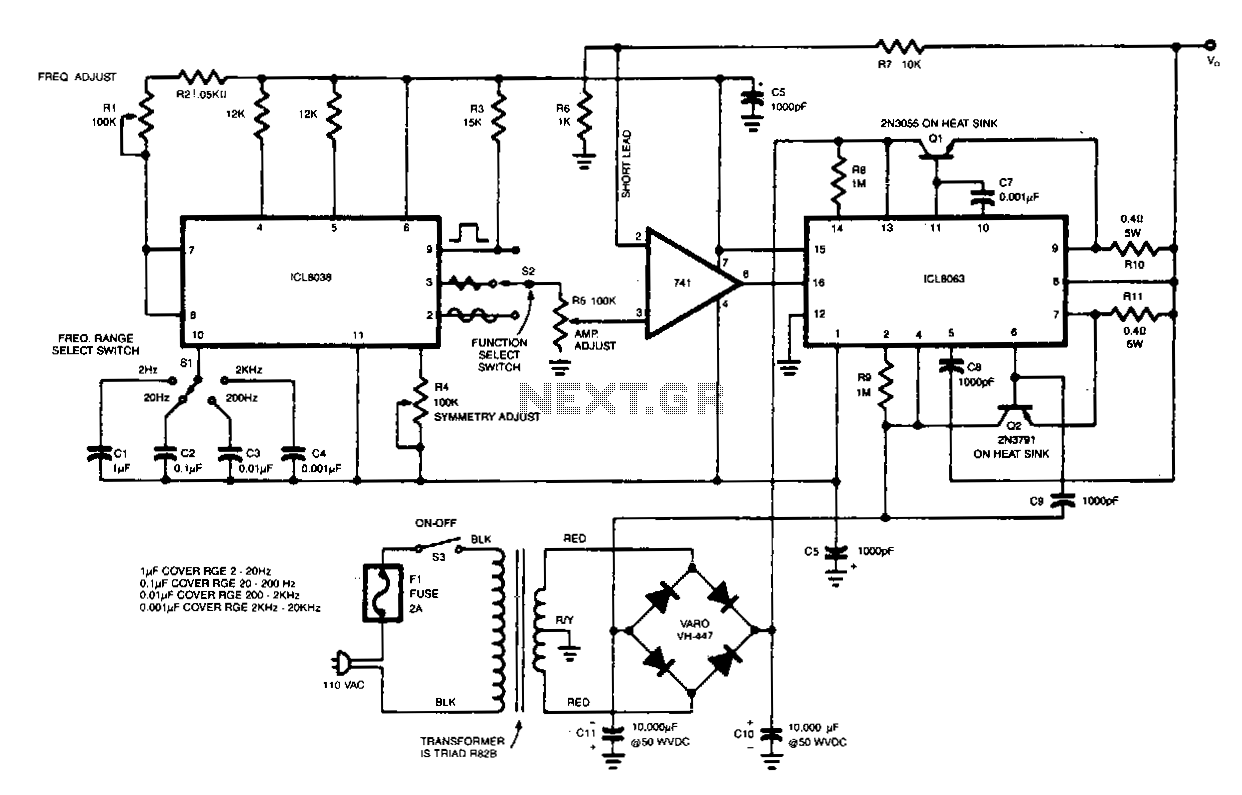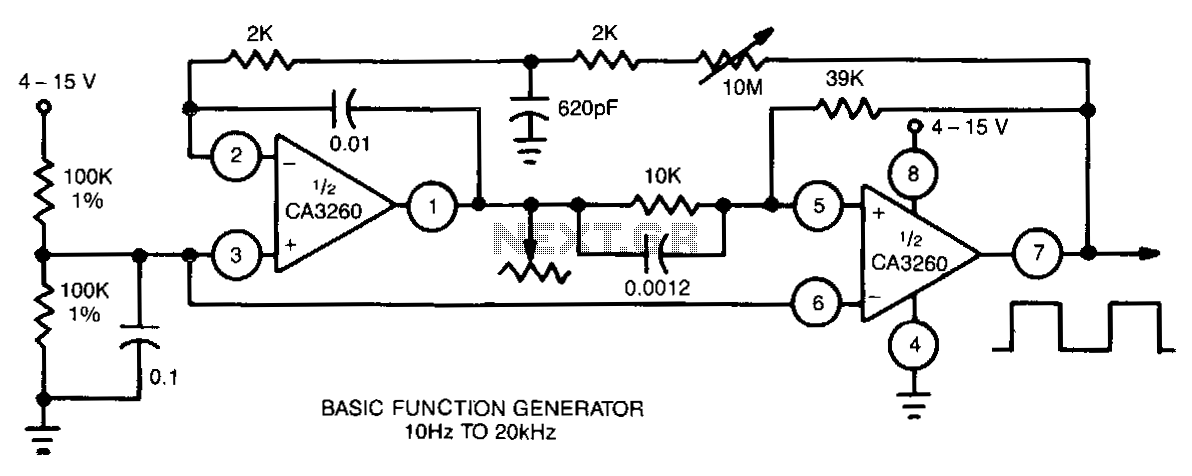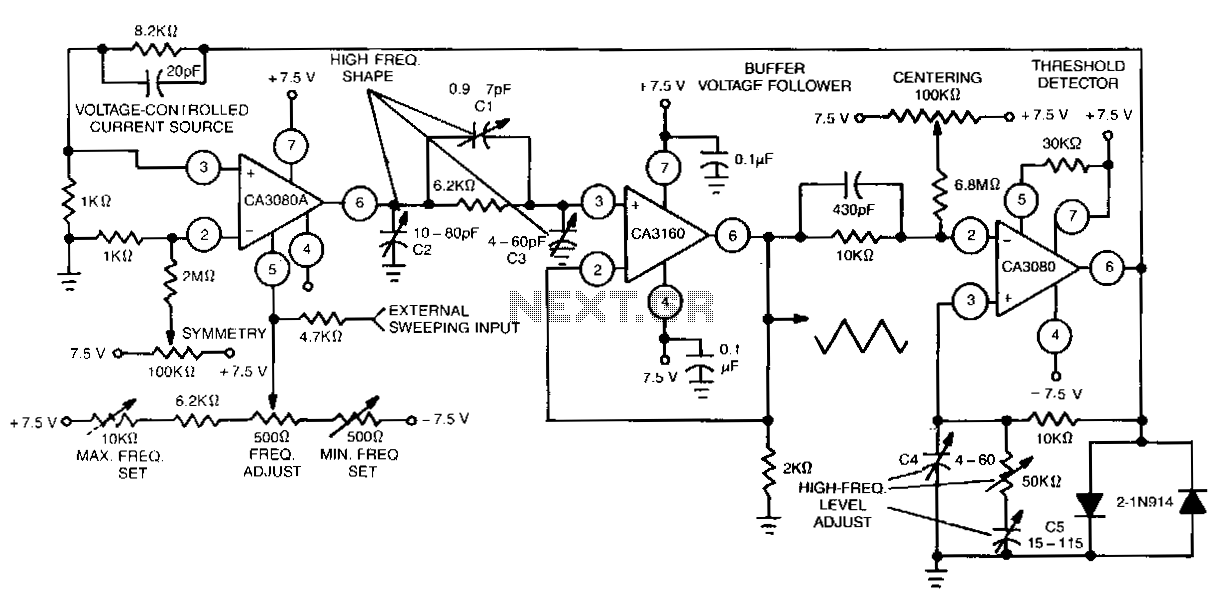
Function-generator

This generator will supply sine, triangular, and square waves from 2Hz to 20kHz. This complete test instrument can be plugged into a standard 110 Vac line for power. VoVT will be up to ±25 V (50 V pk-pk across loads as small as 10 Ω (about 2.5 A maximum output current). Capacitor working voltages should be greater than 50 V dc and all resistors should be 112 W, unless otherwise indicated. More: The interconnecting leads from the 741 pins 2 and 3 to their respective resistors should be kept short, less than 2 inches if possible; longer leads might result in oscillation. Full output swing is possible to about 5kHz; after that the output begins to taper off because of the slew rate of the 741, until at 20kHz the output swing will be about 20 V, ± 10 V. This problem can be remedied by simply using an op amp with a higher slew rate, such as the LF356.
The described waveform generator circuit is designed to produce sine, triangular, and square waveforms across a frequency range of 2 Hz to 20 kHz. The circuit is powered by a standard 110 Vac power source, allowing for easy integration into existing laboratory setups. The output voltage capability is specified at ±25 V, resulting in a peak-to-peak voltage of 50 V across loads as low as 10 Ω, with a maximum output current of approximately 2.5 A.
It is critical to select capacitors with a voltage rating exceeding 50 V dc to ensure safe operation, while the resistors should be rated at 112 W, unless otherwise specified in the design. The operational amplifier (op-amp) used in this circuit is the standard 741, which is known for its versatility but has limitations regarding output performance at higher frequencies.
To maintain signal integrity, the interconnecting leads from the 741 op-amp pins 2 and 3 to their respective resistors should be minimized to less than 2 inches. Longer leads can introduce unwanted inductance and capacitance, potentially leading to oscillation and distortion in the output waveforms.
The generator can achieve full output swing up to approximately 5 kHz. Beyond this frequency, the output begins to diminish due to the slew rate limitations of the 741 op-amp. By 20 kHz, the output voltage swing is reduced to about ±10 V, resulting in a total output swing of 20 V. To overcome this limitation, a higher slew rate op-amp, such as the LF356, may be employed, allowing for more robust performance at elevated frequencies. This substitution will enable the generator to maintain output integrity across the intended frequency range.This generator will supply sine, triangular, and square waves from 2Hz to 20kHz. This complete test instrument can be plugged into a standard 110 Vac line for power. VoVT will be up to ±25 V (50 V pk-pk across loads as small as 10 0 (about 2.5 A maximum output current). Capacitor working voltages should be greater than 50 V de and all resistors should be 112 W, unless otherwise indicated.
The interconnecting leads from the 741 pins 2 and 3 to their respective resistors should be kept short, less than 2 inches if possible; longer leads might result in oscillation. Full output swing is possible to about 5kHz; after that the output begins to taper off because of the slew rate of the 741, until at 20kHz the output swing will be about 20 V,p± 10 V.
This problem can be remedied by simply using an op amp with a higher slew rate, such as the LF356. 🔗 External reference
The described waveform generator circuit is designed to produce sine, triangular, and square waveforms across a frequency range of 2 Hz to 20 kHz. The circuit is powered by a standard 110 Vac power source, allowing for easy integration into existing laboratory setups. The output voltage capability is specified at ±25 V, resulting in a peak-to-peak voltage of 50 V across loads as low as 10 Ω, with a maximum output current of approximately 2.5 A.
It is critical to select capacitors with a voltage rating exceeding 50 V dc to ensure safe operation, while the resistors should be rated at 112 W, unless otherwise specified in the design. The operational amplifier (op-amp) used in this circuit is the standard 741, which is known for its versatility but has limitations regarding output performance at higher frequencies.
To maintain signal integrity, the interconnecting leads from the 741 op-amp pins 2 and 3 to their respective resistors should be minimized to less than 2 inches. Longer leads can introduce unwanted inductance and capacitance, potentially leading to oscillation and distortion in the output waveforms.
The generator can achieve full output swing up to approximately 5 kHz. Beyond this frequency, the output begins to diminish due to the slew rate limitations of the 741 op-amp. By 20 kHz, the output voltage swing is reduced to about ±10 V, resulting in a total output swing of 20 V. To overcome this limitation, a higher slew rate op-amp, such as the LF356, may be employed, allowing for more robust performance at elevated frequencies. This substitution will enable the generator to maintain output integrity across the intended frequency range.This generator will supply sine, triangular, and square waves from 2Hz to 20kHz. This complete test instrument can be plugged into a standard 110 Vac line for power. VoVT will be up to ±25 V (50 V pk-pk across loads as small as 10 0 (about 2.5 A maximum output current). Capacitor working voltages should be greater than 50 V de and all resistors should be 112 W, unless otherwise indicated.
The interconnecting leads from the 741 pins 2 and 3 to their respective resistors should be kept short, less than 2 inches if possible; longer leads might result in oscillation. Full output swing is possible to about 5kHz; after that the output begins to taper off because of the slew rate of the 741, until at 20kHz the output swing will be about 20 V,p± 10 V.
This problem can be remedied by simply using an op amp with a higher slew rate, such as the LF356. 🔗 External reference

